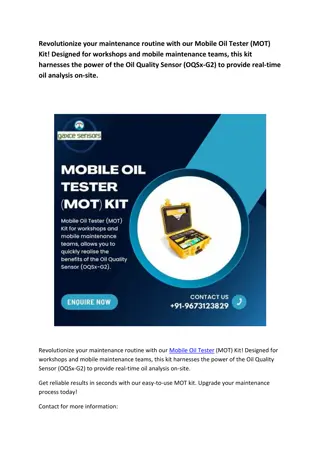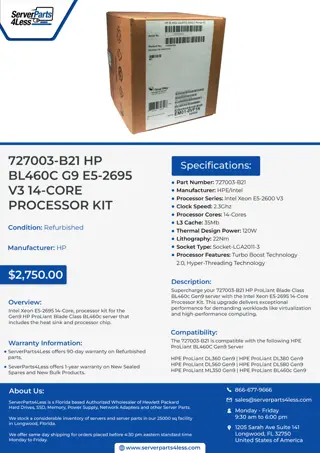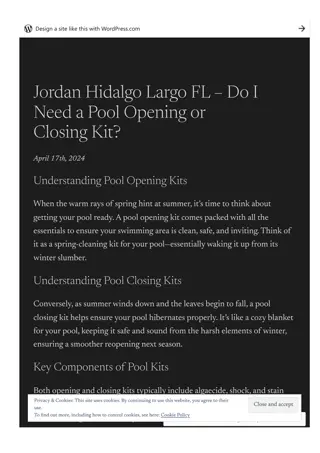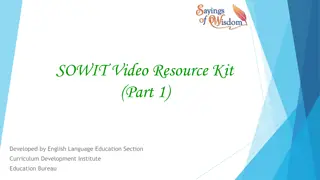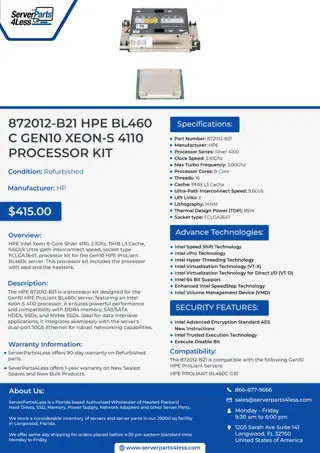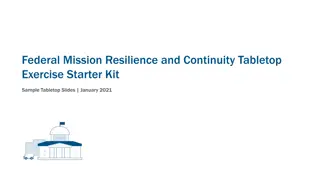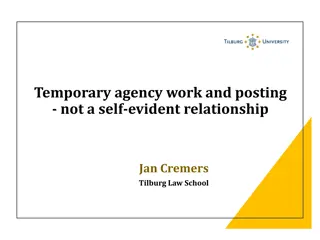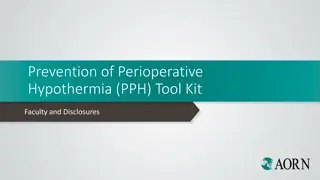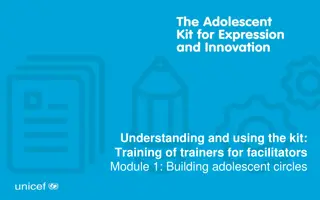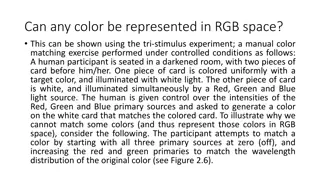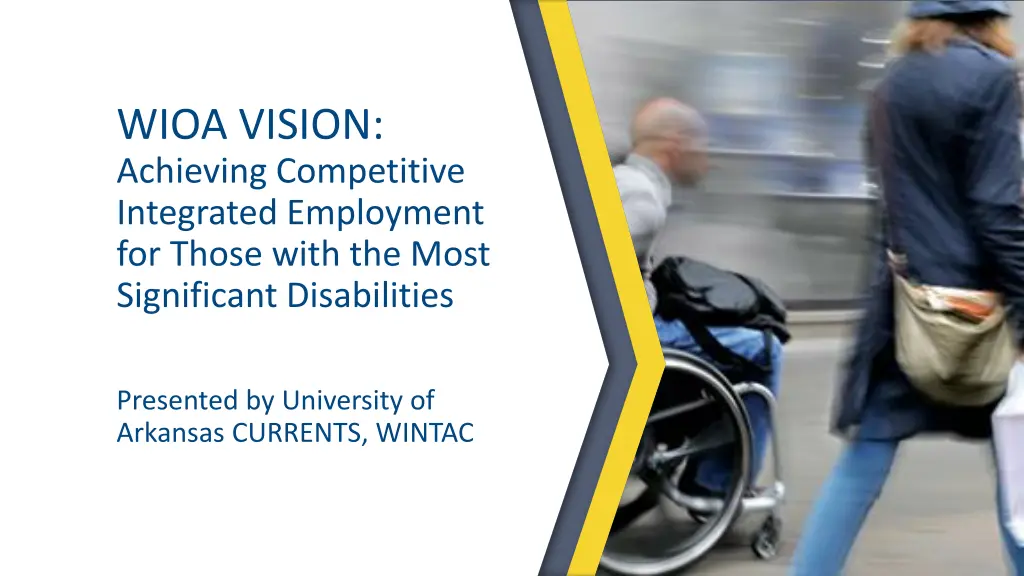
Achieving Competitive Integrated Employment for Individuals with Disabilities
Learn about the vision of achieving competitive integrated employment for individuals with the most significant disabilities through Supported Employment and Customized Employment strategies, ensuring fair wages and benefits in an integrated setting for opportunities of advancement. Explore the essential criteria for Competitive Integrated Employment outcomes and the importance of meeting specific income-related standards. Find detailed information on how work sites can qualify as integrated settings to promote inclusive employment practices.
Download Presentation

Please find below an Image/Link to download the presentation.
The content on the website is provided AS IS for your information and personal use only. It may not be sold, licensed, or shared on other websites without obtaining consent from the author. If you encounter any issues during the download, it is possible that the publisher has removed the file from their server.
You are allowed to download the files provided on this website for personal or commercial use, subject to the condition that they are used lawfully. All files are the property of their respective owners.
The content on the website is provided AS IS for your information and personal use only. It may not be sold, licensed, or shared on other websites without obtaining consent from the author.
E N D
Presentation Transcript
WIOA VISION: Achieving Competitive Integrated Employment for Those with the Most Significant Disabilities Presented by University of Arkansas CURRENTS, WINTAC
PART 1: Competitive Integrated Employment (CIE) VR agencies must achieve Competitive Integrated Employment (CIE) outcomes for those individuals with the most significant disabilities (MSD) utilizing Supported Employment (SE) and Customized Employment (CE) and other effective strategies. "Competitive, integrated employment" (CIE): Full-time or part-time employment (including self-employment) when wage - 1) Is not less than the higher of the rate specified in: Federal, State or local minimum wage law for the place of employment; 2) At least equal to the customary rate paid by the employer for the same or similar work performed by other employees who are not individuals with disabilities and who are similarly situated in similar occupations by the same employer and who have similar training, experience, and skills;
Competitive Integrated Employment (CIE) Income, continued Other income related criteria to achieving CIE outcomes: 3) In the case of an individual who is self-employed, yields an income that is comparable to the income received by other individuals who are not individuals with disabilities and who are self-employed in similar occupations or on similar tasks and who have similar training, experience, and skills; and 4) Is eligible for the level of benefits provided to other employees.
Competitive Integrated Employment (CIE), continued In order meet a CIE outcome, the worksite must meet two criteria: 1. Typically found in the community where the consumer regularly interacts, while performing their duties, with people without disabilities (i.e. "integrated setting ) 2. AND where those interactions typically occur in comparable positions for individuals without disabilities. These positions are intended to provide opportunities for advancement that are similar to those for other employees who are not individuals with disabilities and who have similar positions. More details are available on CIE on RSA s website and on our WINTAC website: http://www.wintac.org/topic-areas/resources- and-strategies-for-competitive-integrated-employment
Competitive Integrated Employment (CIE) Summary THE CIE CRITERIA CAN BE SUMMARIZED AS 5 ELEMENTS: Full-time or part-time employment (including self-employment) that: 1) Meets/exceeds minimum wage (Federal, State or local minimum wage law) 2) Isn t less than the normal/customary rate for similar positions and is eligible for the level of benefits provided to other employees; and 3) Occurs in an integrated setting 4) Position provides opportunities for advancement that are similar to those for other employees who are not individuals with disabilities and who have similar positions. 5) If self-employed, yields income that is comparable to others without disabilities in the general population END OF PART 1, CIE
PART 2: Supported Employment (SE) Overview Supported employment offers THE BRIDGE for individuals with the most significant disabilities to achieve and sustain CIE through intensive on-the- job related support services SE Services Target Consumers: For whom CIE has not historically occurred, or for whom CIE has been interrupted or intermittent as a result of a significant disability; and Who, because of the nature and severity of their disabilities, need intensive supported employment services and extended services after the transition from support provided by the designated State unit, in order to perform this work.
The Law says Supported Employment must occur at a worksite that Meets competitive integrated employment criteria above OR (on an exceptional basis) in an integrated work setting in which individuals are working on a short-term basis (defined in the next slides) Individualized and customized consistent with the strengths, abilities, interests and informed choice of the individuals involved For adults, VR can provide SE services for up to 24 months with some exceptions for extension
The Law also says Supported Employment Services.. For youth, extended services may be provided by VR up to four years, or until the individual turns 25 WIOA now requires 50% of SE funds be used to provide supported employment services, including extended services, to youth with the most significant disabilities SE funds can only be utilized for activities to support individuals once those individuals are placed on a Supported Employment worksite At a MINIMUM, SE (including CE) must occur in an integrated work setting
Supported Employment Services are On-going support services, including job coaching and other on- the-job supports, needed to support and maintain an individual with a most significant disability, including a youth with the most significant disability. Supported employment services are: Organized and made available, singly or in combination, in such a way as to assist an eligible individual to eventually achieve competitive integrated employment; Based on a determination of the needs of an eligible individual, as specified in an individualized plan for employment; Provided by VR for a period of time not to exceed 24 months, unless under special circumstances the eligible individual and the rehabilitation counselor jointly agree to extend the time to achieve the employment outcome identified in the IPE.
Examples of SE Services JOB COACHING and/or consulting with the employer & co-workers Structuring the job, building in cues and feedback, teaching skills, troubleshooting, modeling appropriate behavior Helping with on-the-job social integration and transportation arrangements Coordinating services (e.g. residential, medical, etc.) and connecting with other resources
WHAT is High Quality Supported Employment? High quality supported employment professionals are RESOURCEFUL and will: Use what's there Adapt what's there Supplement what's there Develop natural supports (defined in next slide)
What are NATURAL SUPPORTS? Think of your own job - could you be successful if you were not part of a team or did not communicate effectively with your coworkers? Would you stay at a job if you felt socially excluded? Remember that natural support and job coaching are not mutually exclusive! A good job coach is always looking for opportunities to fade out, which generally means identifying support within the workplace. A natural support model is not the same as place and pray, nor does it necessarily cost less to the funding agency.
WHO provides Supported Employment Services? Some individuals with the most significant disabilities need SE services to achieve and sustain competitive integrated employment. Who provides it? Some VR agencies have internal staff that function in the CRP role, providing job development, placement, coaching, and support. These individuals may be called VR Aides, VR Techs, or employment specialists. Most VR agencies contract with CRPs to provide these services. Sometimes CRP staff are co-located at or assigned to a specific VR office and serve only clients of those counselors.
Typical Supported Employment Service Flow VR gets referral, determines eligibility, develops an IPE that identifies the need for SE services and a provider of extended services VRC and participant identify an appropriate provider of needed services External Community Rehabilitation Program Internal VR staff job developer, placement specialist, job coach etc. Combination of both Referral is made along with authorization for services Job development, job placement, job coaching/training services are provided and billed to the VRC along with progress reports. During this time, the VRC should remain actively involved in the case and oversee the services that are being provided.
WHAT does Supported Employment look like? Often involves helping people access existing jobs in the local community and then providing supports Sometimes group employment as long as it meets the definition of integrated Sometimes involves developing/creating a new position (customized employment) Sometimes involves self-employment
Completing Supported Employment An individual has completed SE when (1) The individual receives up to 24 months (was 18 mo.) of SE; OR (2) The counselor and individual have determined that an extension of time to provide SE services beyond 24 months is necessary to support and maintain the individual in supported employment before the individual transitions to extended services and that extension of time has concluded; AND (a) The individual has transitioned to extended services provided by either the designated State unit for youth with the most significant disabilities, or another provider AND
Completing Supported Employment, continued (b) The individual has maintained employment and achieved stability in the work setting for at least 90 days after transitioning to extended services; AND (c) The employment is individualized and customized consistent with the strengths, abilities, interests, and informed choice of the individual. NOTE: The exception is when the individual has other vocational rehabilitation services listed on the IPE and is working on a short-term basis (defined on next slide) toward the achievement of competitive integrated employment in supported employment. FOR YOUTH (under 25), VR can provide extended services for up to 4 years/up to the age of 25
Supported Employment, Short-Term Basis Under WIOA Supported Employment (SE), Short-Term Basis: As an EXCEPTION, an individual can be placed into a SE worksite on a Short-Term Basis WITHOUT meeting all CIE criteria as long as the SE worksite is in an integrated setting and the individual can reasonably anticipate achieving competitive integrated employment Within six months of achieving a supported employment outcome; or In limited circumstances, within a period not to exceed 12 months from the achievement of the supported employment outcome, if a longer period is necessary based on the needs of the individual, and the individual has demonstrated progress toward competitive earnings based on information contained in the service record.
Supported Employment, Short-term basis continued Starting point of SE Short-Term Basis The six-month short-term basis period, and the additional six months that may be available in limited circumstances, begins after an individual has completed up to 24 months of supported employment services (unless a longer period of time is necessary based upon the individual s needs) and the individual has achieved a supported employment outcome, meaning that the individual is stable in the supported employment placement for a minimum period of 90 days following the transition to extended services. At this point, the individual has achieved a supported employment outcome in accordance with 363.54 described later.
Supported Employment Extended Services Extended Services Definition: (34 CFR Part 361.5 (19)) Ongoing support services and other appropriate services that are: Needed to support and maintain an individual with a most significant disability including a youth with a most significant disability, in supported employment; Organized or made available, singly or in combination, in such a way as to assist an eligible individual in maintaining supported employment; Based on the needs of an eligible individual, as specified in an individualized plan for employment;
Extended Services are also Ongoing support services and other appropriate services that are: Provided by a State agency, a private nonprofit organization, employer, or any other appropriate resource, after an individual has made the transition from support from the designated State unit; and Provided to a youth with a most significant disability for a period not to exceed four years, or at such time that a youth reaches age 25 and no longer meets the definition of a youth with a disability under paragraph (c)(58) of this section, whichever occurs first. VR can only provide extended services to youth with a most significant disability.
Documenting Supported Employment Services.. The IPE for the individual with a most significant disability for whom an employment outcome in a SE setting has been determined must: (1) Specify the supported employment services to be provided; (2) Specify the expected extended services needed, which may include natural supports; (3) Identify the source of extended services or, to the extent that it is not possible to identify the source of extended services at the time the individualized plan for employment is developed, include a description of the basis for concluding that there is a reasonable expectation that those sources will become available;
Documenting SE Services, continued (4) Provide for periodic monitoring to ensure that the individual is making satisfactory progress toward meeting the weekly work requirement established in the individualized plan for employment by the time of transition to extended services; (5) Provide for the coordination of services provided under an individualized plan for employment with services provided under other individualized plans established under other Federal or State programs; (6) To the extent that job skills training is provided, identify that the training will be provided on site; and (7) Include placement in an integrated setting for the maximum number of hours possible based on the unique strengths, resources, priorities, concerns, abilities, capabilities, interests, and informed choice of individuals with the most significant disabilities.
Successful SE Outcomes Once individual is stably employed, funding for services is transitioned to the extended services resource (typically DD or MH)* At least 90 days after this transition takes place, the VR case is closed as successfully employed *ONE EXCEPTION FOR YOUTH VR may pay for the extended services for youth with the most significant disabilities for up to 4 years or until the individual turns 25 years old
Successful Supported Employment Outcomes The key to SE is MATCHING and SUPPORTING the client to the right worksite as the BRIDGE to achieving & sustaining COMPETITIVE INTEGRATED EMPLOYMENT for those with the most significant disabilities Successful VR Outcomes = CIE placement sustained through 2ndand 4thquarter after placement
Non-Traditional SE Providers in Remote Areas While many states struggle with finding adequate SE resources in RURAL areas, Alaska s many small and REMOTE communities present unique challenges. Many Alaskan communities are only accessible by air or boat with only a few VR participants in the community not enough to support a CRP and employment options may be limited too.
Non-Traditional SE Providers contd In order to meet the need for supported employment services in rural areas, Alaska DVR has taken a couple of different approaches. First, they have invited individuals to apply to be an on- call provider of services, without being part of an agency or being accredited. These individuals are required to complete training leading to a Certificate in Employment Services from ACRE. Providers include former teachers, social workers, tribal VR staff, baristas, retirees, business owners you name it. Larry from Ketchikan owns a Ride the Duck business in Alaska s 5th largest city population 8,000
Non-Traditional SE Providers, continued More recently, Alaska DVR has offered free training at the Statewide Special Education Conference to SpEd staff (teachers, aides, etc) who are interested in providing Pre-Employment Transition Services and Supported Employment after school and during the summer vacation. West Virginia VR uses this model too. The school is often the center of these small communities, and the school personnel are well acquainted with individuals who need VR services, as well as with their families and community resources. This model has allowed AK DVR to provide needed services where there is a very small population.
More Supported Employment Examples The next several slides provide illustrations of more typical states with VR agencies that have partnered with CRPs, businesses, county DD agencies, and school personnel to provide SE services. These include: Vermont Progressive Employment used statewide in VT and other states Project Search used in many states to provide services in specific communities across the country WA DVR School to Work used in seven counties across the state
Vermont Progressive Employment Model Many VR agencies are moving toward a progressive employment model. First labeled by Vermont VR and now used in several other states, the key principles are: Everyone is ready for something (businesses and applicants) Small success leads to further success Offer flexibility and low risk to both the business and applicant Eliminate the need to be job ready
Progressive Employment offers A continuum of placement options geared to the skills & interests of the individual and the level of engagement negotiated with the business A method to evaluate existing work skills, reduce fear, and identify training, support, or accommodation needs Options: Practice interview Company tour Job shadowing Short term work experience/internship On-the-job training Temp to hire
More on Vermont Vermont also contracts with CRPs to pay for co-located Business Account Managers ( BAMs ) who work alongside state staff to provide business services and develop Progressive Employment Opportunities. Local teams of VRCs and BAMs meet weekly for Jobsville meetings where labor market, business development, and challenging cases are shared.
Project SEARCH Serving youth with developmental disabilities Successful outcome is competitive employment in an integrated setting Business-led program offers Employment in an integrated setting (that is, working alongside coworkers with and without disabilities) Year-round work (not seasonal employment) 16 hours/week or more along with employment skills curriculum Minimum wage or higher
Project SEARCH Partners Include: Businesses (most often hospitals, sometimes hotels and State/Federal offices) Education/Schools Vocational Rehabilitation Community Rehabilitation Providers Long-term Support Agencies Families Social Security Administration Students work at the business each school day for a minimum of six hours for an entire academic year, experiencing different tasks and locations. Partners provide consistent on-site staff including a special education teacher from the school district and job coaches (usually funded by Vocational Rehabilitation and a supported employment agency and/or the school).
Washington School to Work (S2W) S2W originated as a collaboration among 17 King County school districts, 15 employment support agencies (CRPs), the King County Work Training Program, Washington DVR and DDD S2W takes a team approach. Students with developmental disabilities work with a job coach, their school, their parents, DVR, and DD to help them find a job before they leave school S2W is now active in seven WA counties http://www.kingcounty.gov/depts/community- human-services/developmental- disabilities/services/school-to-work.aspx
Washington School to Work (S2W) contd Job development and coaching staff are provided by CRPs and assigned to a specific school (or schools) CRP staff work with school staff to provide discovery/assessment activities leading to job development, placement, and training/support based on an IPE developed with the VR Counselor VR contracts with and pays the county DD agency a flat fee of $8,670 at the time of each student s job stabilization and transition to DD funded long-term support (Extended Services) Participating counties contract with and pay their CRPs in various ways monthly payments, outcome payments, incentive payments, etc. In some areas, schools also provide FTEs to do job development and placement as part of their transition program
Self-Employment Overview Self-employment; still a viable option Self-employment remains a viable option and can evolve from a variety of VR service approaches including Supported & Customized Employment Self employment is considered competitive integrated employment if it results in an income that is comparable to that earned by: Other individuals who do not have disabilities Who are self-employed in similar occupations or on similar tasks And who have similar training, experience, and skills
Self-Employment as a SE or CE approach Self employment could involve: Business within a business Resource ownership (e.g. owning equipment that is rented/leased out) Sole proprietorship Limited partnerships
Supported Self-Employment Business owners don t have to be able to do everything on their own. Examples of supports arranged to promote success in a window cleaning business: Record-keeping procedures to ensure good business practice Small Business Development Center & parents & employment specialist Assistance with bidding on jobs parents Training on all aspects of window cleaning business A professional staff person with Clearview & Precision Power Washing Assistance with using window cleaning software, simplifying procedures A professional staff person and consumer s parents Taxes, salary, quarterly reports etc. hired an accountant/tax consultant Job coaching when needed employment specialist Info shared by Roger Shelley, U of Alaska CHD
Supported Self-Employment During interviews with Nancy Arnold of the Rural Institute at the University of Montana, VR counselors said they would be more likely to use self-employment if: Their state had self-employment policies, procedures, and guidelines to follow They understood their state s self-employment policies, procedures, and guidelines They had received training on the components of a business plan, and They knew how to evaluate a business plan Alaska VR developed and implemented a very detailed multi-tiered Self-Employment plan which is very helpful!
PART 3: Customized Employment (CE) Overview "Customized Employment" (CE) is defined as competitive integrated employment for an individual with a significant disability, that is: Based on an individualized determination of the unique strengths, needs, and interests of the individual with a significant disability typically identified through an intensive process which is often called Discovery ; Meets the specific abilities of the individual and the business needs of the employer; Is carried out through flexible strategies that customize the job to meet the individual s needs.
Supported versus Customized Employment Michael Callahan (Marc Gold and Associates) explains it this way: Supported Employment is like picking out the carpets and cabinets in a house you make minor modifications in an existing job based on your preferences and needs. Customized Employment is like sitting down with an architect and designing the house from scratch you are creating a job that benefits both the business and the employee.
Customized Employment (CE) Strategies Flexible job customization strategies to build the new job include: Task reassignment: Some of the job tasks of incumbent workers are reassigned to a new employee. This reassignment allows the incumbent worker to focus on the critical functions of his/her job (i.e., primary job responsibilities) and complete more of the central work of the job. Task reassignment typically takes the form of job creation, whereby a new job description is negotiated based on current, unmet workplace needs. Job carving: An existing job description is modified containing one or more, but not all, of the tasks from the original job description.
Customized Employment (CE), Strategies, continued Job customization strategies also include: Job sharing: Two or more people share the tasks and responsibilities of a job based on each other's strengths. Self-Employment as a form of Customized Employment: Self Employment allows for an individual to receive assistance in the creation of an independently owned small business (typically a micro enterprise, under five employees) based on the strengths and dreams of an individual and the unmet needs of a local market while incorporating the individualized planning and support strategies needed for success. Job Creation: A new position is created to meet unmet need or needs of an employer that are also customized to fit the individual
Those are Customized Employment Outcomes How do We Get There? First determining the unique strengths, needs, and interests of the individual often done through an intensive, ecological based discovery process. Sometimes this is completed by the school or DD agency prior to referral to VR; sometimes it is a service provided with VR funds This information allows us to effectively negotiate with business to: Customize a job description based on current or previously unidentified/unmet business needs Developing a set of job duties, work schedule and job arrangement, and specifics of supervision; negotiating these with the employer May need to provide services and supports on the job (SE services)
Customized Employment (CE) WIOA requires Customized Employment (CE) outcomes but does not define a process to achieve it. However, the CE process is generally recognized to have 5 important Customized Employment components (Marc Gold and Associates and supported by ODEP) 1. Discovery 2. Narrative or Visual Profile that captures the Discovery information 3. Customized Planning Meeting: Developing the employment plan 4. Development of a Representational Portfolio 5. Customized Job Development NOTE: These 5 Customized Employment competencies are described in more detail at: http://marcgold.com/Publications/White%20Papers/Customized%20Employment.pdf
FOR ADDITIONAL INFORMATION CIE, SE and CE resources via WINTAC at: http://www.wintac.org/topic-areas/resources-and- strategies-for-competitive-integrated-employment Technical Assistance: Sean O Brien, sean.obrien@uacurrents.org END OF PART 3: Customized Employment
PART 4 BUSINESS ENGAGEMENT: Effectively Serving Our Businesses in the New DUAL Customer Approach http://www.orchardhill.ac.uk/supported-employment/
Business Engagement Overview Business Engagement (BE) is interaction between employers, vocational rehabilitation (VR), and other workforce development and education organizations that results in measurable improvement in desired outcomes. Effective BE bridges the gap between employer demand for a capable workforce and the supply of workers with the abilities to meet those job demands Under WIOA, Dual Customer Approach is now required and incorporated into VR s performance measures. Both Consumers AND Businesses are VR s mandated customers.
Business Engagement Performance Measures In Hawaii, Business Engagement related outcomes will be measured by tracking two criteria that relate to increasing repeat business, and employee retention rates: REPEAT BUSINESS : Record the number of establishments that received a service or are continuing to receive a service or other assistance during the reporting period AND who utilized a service anytime within the previous 3 years AND RETENTION : A participant is employed by the same employer for 2nd and 4th quarters after exit. This information is already collected by the individual participant and is part of the Participant Individual Record Layout (PIRL).



